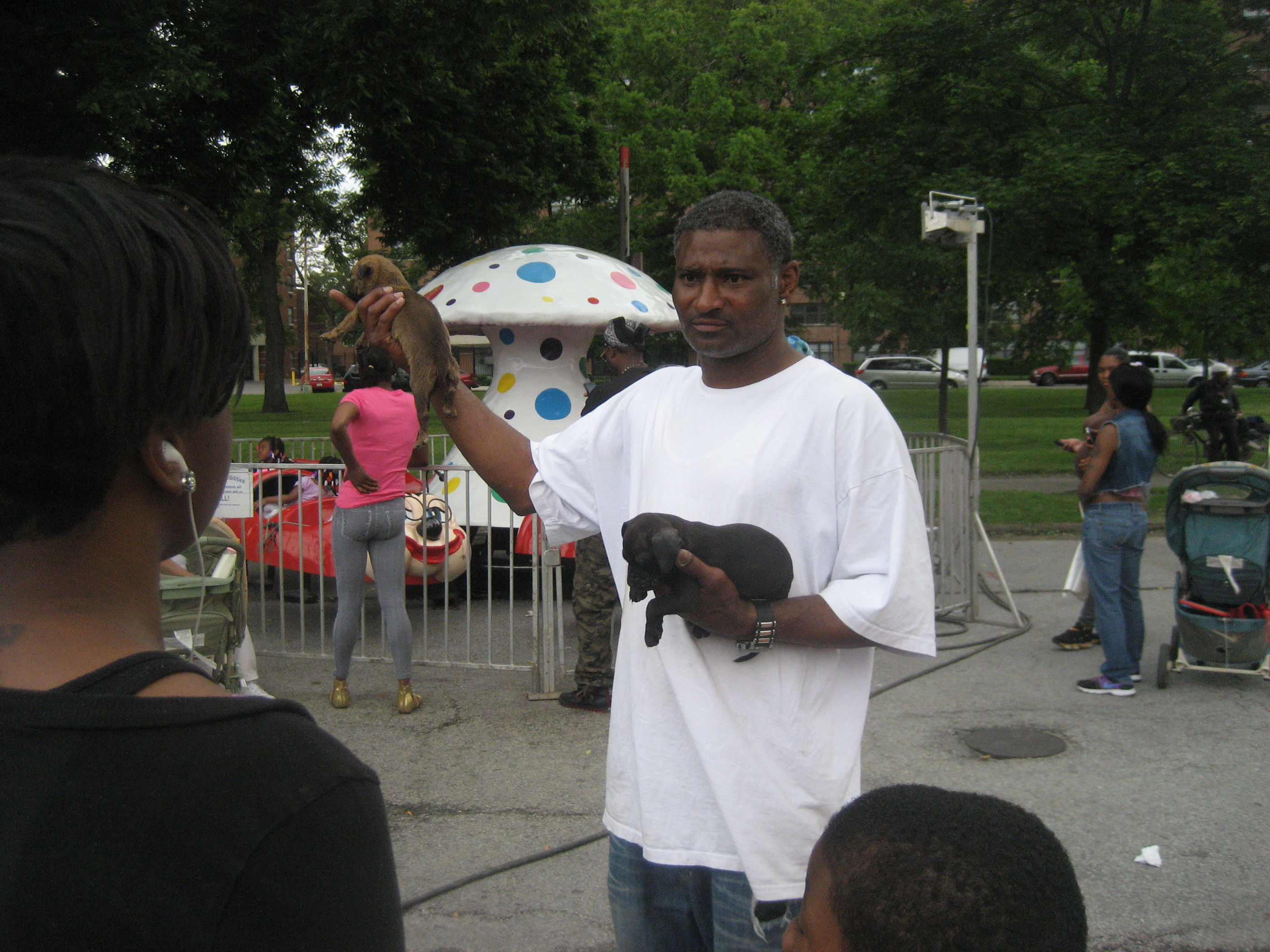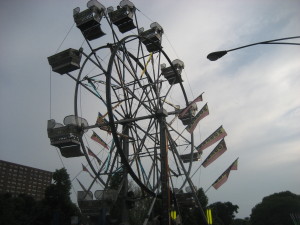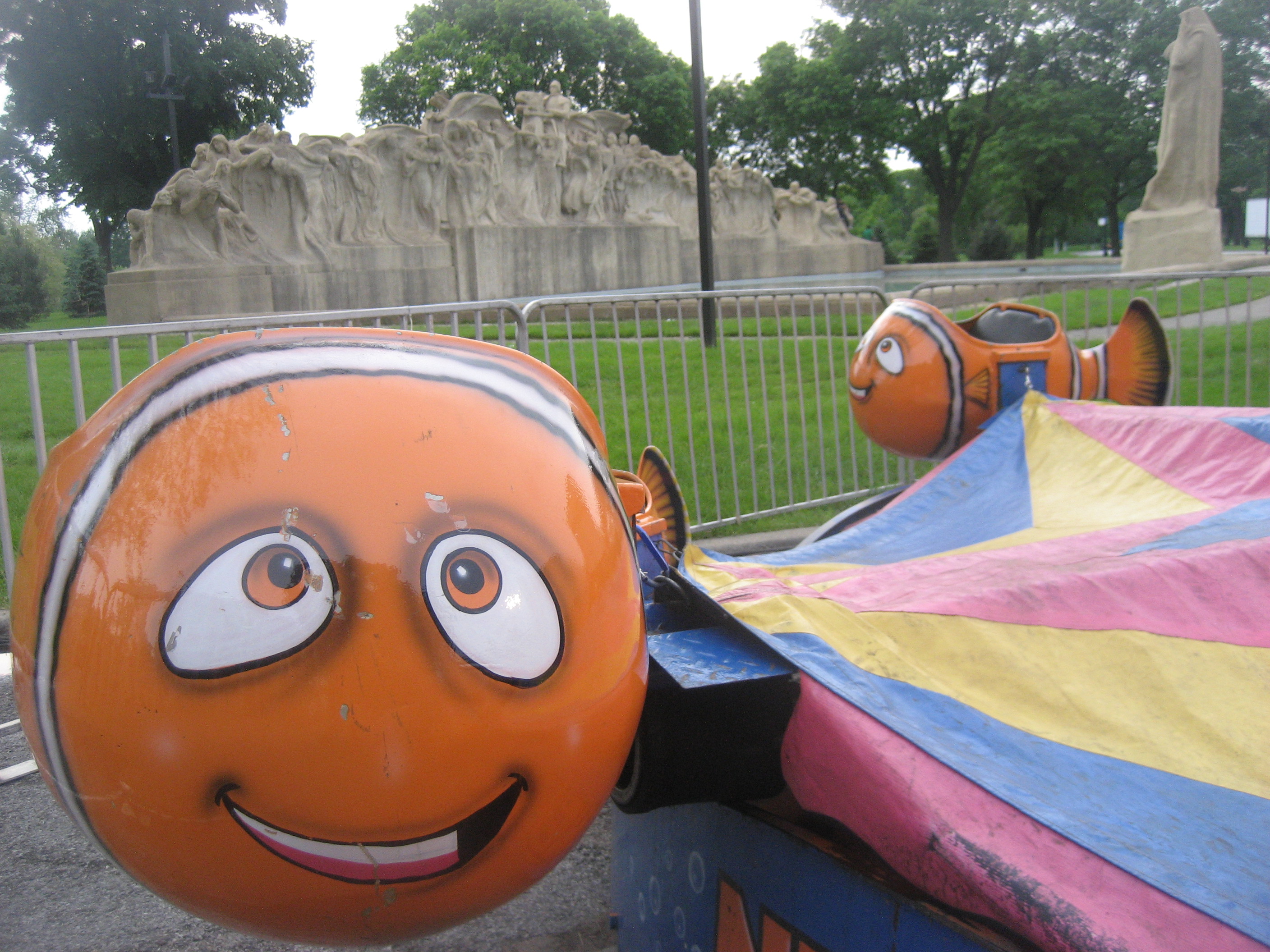
Chicago Southsider sells Rottweiler pups along the Midway Plaisance, Chicago, the site of the original midway.
———————————————————————————
“Work is about a search for daily meaning as well as daily bread, for recognition as well as cash, for astonishment rather than torpor; in short, for a sort of life rather than a Monday through Friday sort of dying.” ― Studs Terkel
Boogie ran a spinning Century, near the first Ferris Wheel at the birthplace of American traveling carnivals.
Standing high on the launching ramp, he watched neighborhood crowds lining up below. He was proud to be part of it all – Chicago, history and living in these days.
Boogie ran the Century Wheel, a premium Ferris wheel in use in the bigger traveling carnivals. A Black man in his 30s and strong-looking, Boogie wore a flashy, baggy jacket. He had a way of attracting other carnies to the wheel to talk to him. Something about Boogie, people liked talking with him.
During a rain break I took time to talk to Boogie. I mentioned that I was woken by a cow face looking at me that morning at The Dirty 30, the carny quarters along U.S. Route 30, in Chicago Heights, on Chicago’s far Southside. The owners kept 40 Black Angus cows on the same lot as the carny quarters.
Boogie laughed but he wanted me to know that cows are part of Chicago’s history.
“Remember, a cow is responsible for all the good shit we have around over there,” he said pointing to downtown Chicago, the focus of Chicago tourists and photographers.
Boogie was referring to the legend of “Mrs. O’Leary’s Cow,” which was blamed for knocking over a lamp and starting the 1871 Great Chicago Fire. After the fire, Chicago rebuilt and has been reinventing itself ever since.
Boogie was hazy on the details but he knew about the Union Stockyards, which operated near our site.

Cow herd on the “Dirty 30” along US 30, the Lincoln Highway, through Chicago Heights, on Chicago’s far Southside.
He also knew the first Ferris Wheel, a elephantine version of his wheel, operated just a few blocks away, “a long time ago.”
However, I was up on my Chicago history because I’d recently been rereading “Devil in the White City,” which featured the 1893 World’s Columbian Exposition. I also spent years as a journalist in the area and drank in the Chicago history and lore. Where Boogie was hazy, I stepped in with the background. After that night, he consistently would ask, “Why you know so much about Chicago?”
I was glad he knew what he knew, it meant some inner city kids in Chicago still grow up knowing something about its past. Chicago kids like Boogie still see how it spins through their lives.
EyesLikeCarnivals traditions
The 1893 World’s Fair was called “the fair that changed America” and it still lives on in names and traditions in Chicago. The concept of a midway with games and shows down a main street of entertainment was a centerpiece of the fair. These days, Chicago has Midway Airport, Midway Airlines and the Monsters of the Midway, the Chicago Bears. Restaurants, bars and even churches have Midway in their names.
“Modern Midways” was the name of the carnival I worked for in Chicago, in some of Chicago’s toughest neighborhoods. We also played hollowed ground for carnivals, the Midway Plaisance, the exact 1 mile site of the original midway.
Midway Plaisance was the site of the original Ferris Wheel. Galesburg, Il.-born George Washington Gale Ferris Jr. built the Chicago wheel with 36 cars, holding a capacity of more than 2,000 people. It took 20 minutes to turn twice. Some cars featured waiters.
The World’s Fair played for six months and drew crowds of 27.5 million at a time when the entire country totalled just 65 million people. (btw, we now number about 312 million).The fair made such a national splash that waves of smaller traveling carnivals followed with rides, games, freak shows, burlesque, carousels and Ferris wheels.
They spread out from Illinois and, as one carnival manager recently told me, Illinois is still “a busy state for carnivals.”
Traveling shows or circuses, even smaller versions of the Ferris wheel have existed for centuries but the North American carnival traces back to that Chicago World’s Fair, with its Ferris wheel and midway.

The Big Eli made in Jacksonville, Il. on the first midway along Midway Plaisance, with the University of Chicago Hospital in the background.
At that Washington Park jump, we put up a Big Eli, made by Eli Bridge Co. of Jacksonville, Il., which traces its roots back a century. Known as a “wheelman,” Boogie ran both the Century in Gage Park and the Big Eli along Midway Plaisance.
We were just blocks away from the union stockyards, at one time the largest meat producing square mile in the world. Meatpacking names from that era like Swift and Amour still thrive.
It’s squalid conditions became the subject of Upton Sinclair’s “The Jungle.” Also a journalist, Sinclair worked in the stockyards before writing the book, as I’m working in traveling carnivals hoping to write a book.
Another writer Bertoldt Brecht wrote a play about downtrodden labor in “Saint Joan of the Stockyards.”
Brecht was a favorite of Chicago author Studs Terkel, who I interviewed a few times. Terkel quoted a Brecht poem in his autobiography “Touch and Go.”
“Caesar beat the Gauls. Was there not even a cook in his army?”
“Phillip of Spain wept as his fleet was sunk and destroyed. Were there no other tears?”
Studs wrote “Working” about the people not included in history’s narrative. I also wrote a five-section special edition of the Elgin Courier-News in the 1980s called “Working,” citing Terkel. It included nearly 100 profiles of Fox Valley area people from a struggling car washer to rags-to-riches entrepreneurs.
Studs called the newsroom to compliment me. I was out at the time but the compliment made it to the whole office as our loud secretary yelled his words across the newsroom to me later.
“Studs Terkel called and said he loved your series, whatever the name of it was,” she yelled.
“EyeLikeCarnivals” isn’t “The Jungle” or “Working” or “Saint Joan of the Stockyards,” yet it is in that tradition of living, working and writing about the lives inside history’s big narrative outline.
Standing outside that story timeline, on the western edge of Midway Plaisance, is Father Time watching the Fountain of Time. The 126-foot fountain shows the passage of time, with people parading past Father Time in what appears to be the sands of time. The fountain added a historic feel to our Midway Plaisance shows. The fountain is a landmark but on hot days local kids flock to the fountain, jumping and playing as if part of a living work of art.
I chose carnivals to write about because they operate in town centers across the country. The focus of the community often is an annual event and each has workers with lives as colorful as the carnivals they work.
Along the way, so many people I met related how they once worked with a carnival, loved carnivals, or always wondered what kind of life carnies live. Let them wonder away. Let them come ride and play. They are important, they are the show.
And near the Fountain of Time, Boogie shifted the lever back and forth on the spinning Century, watching today’s crowds thrill on the ‘modern’ midway.

Nemo’s kiddy ride in front of the Fountain of Time on Midway Plaisance, Chicago, site of the original carnival midway.
——————————————————————————————————————-
From 2013-2014, Michael Sean Comerford worked in carnivals in California, New Jersey, New York, Chicago, Alaska, Minnesota, Oklahoma, Texas, Georgia and Florida, where he worked in a freak show but didn’t get on stage because they didn’t see the inner freak in him. He rode a bus into the mountains of the Sierra Madre Oriental to a Mexican village that empties of men each year, going north to US carnivals. Living on carnival wages, he hitchhiked 15,000 miles across 36 states. His blogs appear in Huffington Post and at www.EyesLikeCarnivals.com. Agent Tim Hayes is seeking a publisher for the book.
